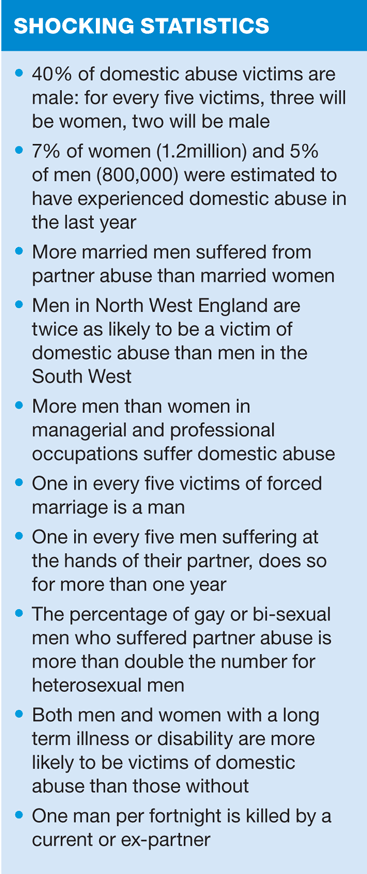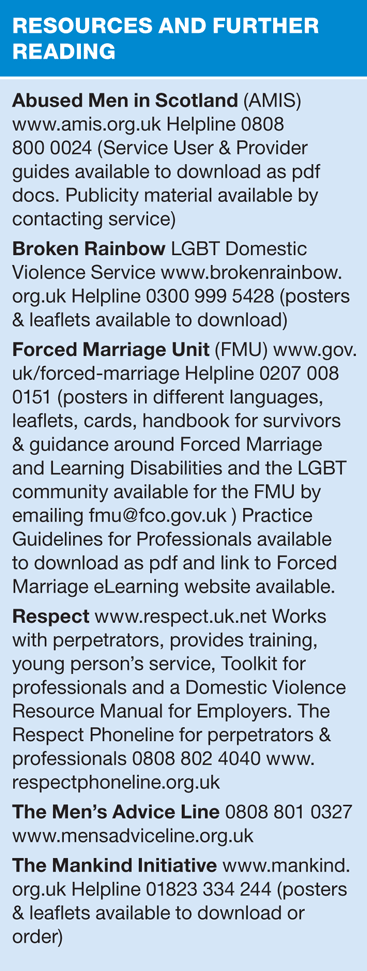Understanding domestic abuse in men
Margaret Umeed
Margaret Umeed
RGN MSc. FFTM (RCPSG) FQNIS
Margaret Umeed, Specialist Nurse Practitioner (General Practice) Margaret Umeed has worked in General Practice in Glasgow since 1990. She currently works full time in a socio-economically deprived area of South Glasgow, in a practice that ranks number 50 in the top 100 most deprived practices in Scotland.
When we think of domestic abuse, it is natural to assume that women are always the victims and men are the perpetrators — but nothing could be further from the truth
The UK Government defines domestic abuse as 'Any incident or threatening behaviour, violence or abuse (psychological, physical, sexual, financial or emotional) between adults who are or have been intimate partners or are family members, regardless of gender or sexuality.'1
Most nurses working in general practice will come across domestic abuse at some point: the woman who presents for cervical cytology with unexplained bruising on her legs, the toddler who presents with burns in odd places from a pair of hair straighteners, the four year old who doesn't cry during immunisation. But how often do we encounter abuse in our male patients? Would we recognise it when a man presents with domestic abuse perpetrated by his partner? Yet this problem is far more common than most of us realise.
Statistics would suggest that a staggering 2.9 million, or one in six men, have suffered some kind of domestic abuse since the age of 16 years. Furthermore there have been an estimated 800,000 male victims of domestic abuse during the last year. For every five victims of domestic abuse, three will be women, two will be men.
The number of women convicted of perpetrating domestic abuse has more than quadrupled in the past seven years: from 806 in 2004-05 to 3,965 during 2010-11.2 However, domestic abuse is not exclusive to heterosexual relationships. Gay and bisexual men and women are statistically more likely to suffer from partner abuse — 6.2% of men and 12.4% of women compared to heterosexual men (3.3%) and women (4.3%).2 Furthermore, men who suffer long term illness or disability are more likely to be victims, as demonstrated by the high profile cases of Stephen Hawking,3 and Eddie Kidd.4
This article was prompted by the publication of a literature review earlier this year, by Brian Dempsey on behalf of AMIS (Abused Men In Scotland).5 The purpose of Dempsey's 'action research', was that the information presented would:
- Be used as a reference point for future research and policy development in relation to the many issues surrounding men's experience of domestic abuse
- Empower men who have experienced domestic abuse to contribute to filling in the gaps in our knowledge and
- Support and inform service providers who seek to respond to all those who experience domestic abuse and the children affected by that abuse.5
It is especially disappointing to note then, that while the author of this article appreciates the Dempsey literature review was written primarily for Scottish service providers, the National Institute for Health and Care Excellence (NICE) appears to have completely disregarded this piece of research when compiling its latest draft guidance.6 NICE states in the introduction, 'Men are more likely than women to perpetrate this type of violence and abuse... Given the lack of evidence (author's emphasis) on men who experience domestic violence and abuse, most of the recommendations are for women. However, men who experience domestic violence or abuse also need support.'6 A brief look at the websites mentioned in the sources of information for this article will generate a plethora of information, facts and action points for both the abuser, the abused and the service provider.
KEY FINDINGS
Dempsey's review covered eight key areas:
1. The absence in the literature of 'the voices of those men who have experienced domestic abuse': abused men are often categorised as being 'hard to reach' but Dempsey points out that with appropriate motivation, researchers can find ways to access men's experiences.
2. Under-reporting: 28% of male victims do not tell anyone about their abuse. Male victims are three times more likely than a female victim NOT to tell the police and only 4% will tell a health professional.2
3. Forced marriage: statistics from the Home Office Forced Marriage Unit (FMU) indicate that approximately 18% of forced marriages involved male victims.7 Although there are no specific figures relating to the men who were forced to marry, the FMU reports that last year, of the 1485 cases, 114 cases involved those with disabilities and 22 involved those who were lesbian, gay, bisexual or transgender.8
4. The reported impact of domestic abuse on men: the review makes the point that just as the types of abuse suffered by men are similar to those suffered by women, what appears to be different is the unwillingness on the part of many men to take the abuse they suffer seriously. Research has shown that abused men suffer from difficulty sleeping, nightmares, depression or low self esteem, relationship difficulties, fear, anxiety and panic attacks, and isolation from family and friends. Sexist stereotyping of what it is to be a 'real man' means that many abused men take the view that the abuse they were subjected to was 'just something that happens'.
5. Attempts by men to hide their abuse from family, friends and workmates by (mis)using alcohol and spending long hours at work. At a UK level, gay and bisexual men who disclose that they are victims of abuse, will seek help from friends, counsellors or relatives rather than GPs, gay support services or the police.
6. The need for services to be inclusive to all men regardless of age, ethnic status, heterosexual, gay, bisexual, transgender, father, disabled, asylum seeker or economically disadvantaged.
7. Access to services: men are less likely than women to take time off work to attend medical appointments, and perceive that accessing services can be seen as 'unmanly'. Fear of stigmatisation is a significant barrier.
8. Understanding the perpetrators of abuse against men: there is currently no service for perpetrators of abuse (either men or women) in Scotland, however, the charity Respect does work with perpetrators and offers a telephone helpline and website (see sources of information).
WHAT CAN WE DO AS PRACTICE NURSES?
We need to recognise that domestic abuse against men exists. Many men will not admit they are victims for fear of not being believed, or being ridiculed or stigmatised. As a profession, we have a duty of care to all the people we come into contact with.
Read the case study. Is this your surgery? Would you have identified this man as a victim of domestic abuse? Would you have believed his story? Do you see every patient who registers with the practice? If not, is this a missed opportunity for all sorts of screening activity? Would you have picked up the cues in the conversation?
Read the case study again. This time underline all the cues during the consultation. Look at your practice through the eyes of the service user. Do you have posters in the waiting areas advertising a policy of confidentiality no matter what the age of the service user? Do you have a practice information booklet that you give to patients? Does it have a list of useful telephone numbers or websites that you could add to? Does your surgery website have a 'Links' page that you could use to add a direct link to some of the websites mentioned in this article? Are you able to order and display some of the posters and leaflets mentioned, or perhaps print them off? Why not distribute them to colleagues, or save them on the Public Drive of the computer system so other health professionals can access them when they need to. What about organising a Practice Learning Event for everyone: reception staff, GPs, nurses, health care support workers, health visitors, to raise awareness. Distribute materials, use the case study for discussion, or even better, use the toolkits and eLearning resources available.
The worst accusation that a patient can ever level at a practice is that the practice staff, doctors or nurses were apathetic towards them. Patients need empathy not apathy, and signposting to appropriate services, a 'can do' attitude, not 'I can't do that'. And please, can someone tell NICE about the scale of the problem of domestic abuse of men?
REFERENCES
1. Mankind Initiative (MI) (2013) Support for Male Victims of Domestic Abuse or Domestic Violence. Available at: http://www.mankind.org.uk Accessed:23 July 2013
2. Mankind Initiative (MI) (2013) Male victims of domestic and partner abuse 21 Key facts. Available at: http://www.mankind.org.uk Accessed: 23 July 2013]
3. Harrison, D. (2004) Police plan to ask Stephen Hawking about abuse claims. Available at: http://www.telegraph.co.uk/news/uknews/1452516/Police-plan-to-ask-Stephen-Hawking-about-abuse-claims.html Accessed: 4 August 2013
4. Press Association. Wife of paralysed former stuntrider Eddie Kidd jailed for domestic abuse. http://www.theguardian.com/uk-news/2013/aug/01/wife-eddie-kidd-jailed-domestic-abuse Accessed: 8 August 2013
5. Dempsey, B. (2013) Men's experience of domestic abuse in Scotland. What we know and how we can know more. AMIS/University of Dundee. Available at: http://www.amis.org.uk Accessed: 23 July 2013
6. National Institute for Health and Care Excellence (NICE) (2013) Domestic violence and abuse — identification and prevention: draft guidance. Available at: http://www.nice.org.uk Accessed: 2 August 2013
7. HM Government UK (HMG) (2009) Multi-agency practice guidelines: Handling cases of forced marriage. Available at: http://www.gov.uk/forced-marriage Accessed: 3 August 2013
8. Home Office / Foreign & Commonwealth Office (FMU) (2013) Forced Marriage Unit (FMU): Statistics January — December 2012. Available at: http://www.gov.uk/forced-marriage Accessed: 3 August 2013
Related articles
View all Articles



